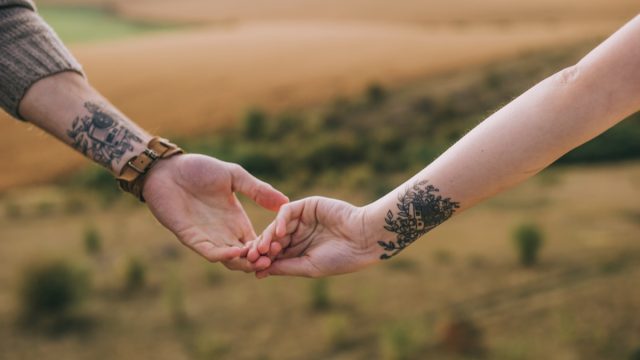A Therapist Explains What Your Attachment Style Says About Your Relationships
Find out whether your attachment style is anxious, avoidant, or secure—and what that means.

As a therapist who focuses on modern love, I work with individuals and couples in decoding their relational experiences. These inquiries range from "Why was I ghosted?" to "Am I with the wrong person?" Each exploration is aimed at answering the underlying question: "Why isn't this connection working and how do I make it work?"
What is attachment theory?
Attachment theory, introduced by British psychologist John Bowlby in the 1950s, is the most widely cited and sound science we have available to help us understand how we relate to others and why we choose them as partners. Observations of mother/infant dynamics have been used as a basis to show us that the relationship we have with our parents or caregivers as babies impacts the types of relationships we have with our romantic partners.
Despite its universal application, attachment theory has been criticized for being ethnocentric and ignoring the different cultural contexts in which it is rooted. For example, certain behaviors in Western culture might be viewed and interpreted differently in certain Asian cultures. It is important to be mindful that what I propose here is just a model, and that the fixed descriptions may not wholly describe you.
What is my attachment style?
According to attachment theory, each of us relates in one of three distinct ways. None of these styles are "bad" or "good." Instead, they orient us to our needs so that we are better able to advocate for ourselves and choose partners who are best suited for us.
Anxious attachment style (20 percent of the population)
These individuals are worried about their relationships and are often concerned about their partner's capacity to return the love they give. Example beliefs: My partner doesn't want to be as close to me as I do to her; I can adapt my mood to meet my partner's needs; If my partner is in a bad mood I automatically believe it is something I did wrong.
Many anxiously attached children were required to attune to their caregiver's needs or had a parent that did not nurture their independence, learning that in order to "get" they had to "give" first. This made it difficult for them to trust that they are loved for who they are at their core, not solely for what they do for others. Their lovability quotient may have been dependent on approval as young people.
Avoidant attachment style (25 percent of the population)
These individuals feel like being a part of "we" means that independence is lost and therefore avoids intimacy. Example beliefs: I don't need anyone; I can do it all on my own; If I don't rely on others I can't be hurt by them.
In this case, the child was forced to adapt to a world in which attachment figures were not available, and therefore turned to toys, books, and imaginary relationships as replacements. The caregivers may have been repelled by the child's need for closeness.
Secure attachment style (50 percent of the population)
These individuals feel at ease with closeness and are often said to be "loving" people, maintaining the sweet spot between independence and interdependence. Example beliefs: I deserve to give and receive love and affection; I believe it's my right to have my needs met and it's my responsibility to advocate for them; I support my own independence and that of the person I am in a relationship with.
In children with secure attachment, we can see they possess the freedom to ask for what they want and they are easily soothed when they don't get it. This means that their caregivers were often emotionally—not just physically—present, attuned to and accepting of their children's needs.
The Science of Romantic Attraction
Ironically, people with anxious and avoidant attachment styles often end up in relationships with one another. "With nearly all of the couples I have worked with, ranging from Hispanic couples, interracial couples young and old, gay and straight couples, even polyamorous couples, not to mention those who want to be in a relationship, I have found that people nearly always adopt one of two complementary roles with each other," writes New York City-based couple's therapist Benjamin Seaman in his book The Hidden Dance.
In their most distressed states, the anxious/avoidant relationship dynamic can be a painfully ineffective and monotonous game of push and pull. For this reason, some relationship experts recommend that both anxious and avoidant systems resist dating, and instead couple up with secure systems.
In their book Attached, psychiatrist and neuroscientist Dr. Amir Levine and Rachel Heller warn individuals from mistaking an activated attachment system—longing for a person who is sending messages that he/she/they are unavailable—with feelings of love. "Next time you date someone and find yourself feeling anxious, insecure, and obsessive—only to feel elated every once in a while—tell yourself this is most likely an activated attachment system and not love. True love, in the evolutionary sense, means peace of mind."
In reality, it's difficult to deny the existence of something that feels like love. Not to mention, many of us are already deeply entrenched in anxious/avoidant unions, so I propose a framework and a set of five tools for navigating relationship conflicts in a way that better serves you and your partner.
1. Understand the dependency paradox.
The dependency paradox says we can only be independent when we have a predictable relationship with dependency. For example, children with secure attachments are capable of taking risks and exploring solely because they know that their caregivers will remain a reliable source of presence and nurturance upon returning to the home base. Similarly in adulthood, in order to feel safe in romantic relationships, our partners must be able to answer the question "if I need you, will you be there for me?" affirmatively.
Meanwhile, in Western culture, being called "reliant" or "needy" is insulting and connotes weakness. And yet we know from science that humans are wired for connection and those of us who have high-quality relationships, live longer and healthier lives, experiencing less memory loss and cognitive decline. The soothing effects of connection can even be seen in scans of areas deep in the brain.
In his 2006 study of heterosexual couples, researcher Jim Coan identified that when a loved one holds your hand in a time of distress, it takes the hurt away. Those who were touched by their partners rated their pain significantly less than those who had to experience the pain alone. Reframing "neediness" as "humanness" is an essential first step in building effective connections.
2. Identify protesting behavior.
Because of our basic need for closeness, we protest when we don't get it. A protest behavior is an action that attempts to get our partner's attention in order to ensure we remain in relation to each other. These actions can range from excessive text messages and attempts to make our partner jealous to eye-rolling, walking out of the room, ignoring calls, and threatening to end the relationship. Each of these is an attempt to be noticed and a call for connection; however their impact often results in communicating the opposite sentiment.
Instead of protesting, acknowledge that your attachment system is being activated, clueing you into a need you might be having. Ask yourself: what am I needing right now that my partner isn't giving me? And, is this a need that I can meet myself, get from another relationship in my life, or find the words to ask my partner for in a succinct request?
3. Differentiate between past and present.
When our emotional response seems outsized (feeling like "I don't matter" to my partner because she forgot to walk the dog) or diminished (rolling my eyes when my partner is crying) in relation to its trigger, it likely has historical roots. Differentiating between the wounds of the past and the current transgressions creates opportunities for new storylines in our attachment narratives. Empathy for our partners may begin by sharing what didn't feel safe for us as children, and how this gets galvanized in the present dynamic. A simple statement like: "This is how I acted in childhood in order to survive, and I see that this response is coming up right now in our argument" might help to reduce finger-pointing and increase relational safety.
In times when there is a failure of safety, place blame on the past hurt instead of the present interaction. Trauma psychotherapist Dr. Janina Fisher, recommends the language: "If it weren't for your damned trauma [fill in the blank: neglect, abandonment, abuse, unrealistic expectations, rejections for failing, judgment], you would feel safe together even when one of you is being a jerk!"
4. Blame the dynamic, not the individual.
Often times our "survival positions," the beliefs and strategies we put in place in order to get our fundamental needs met, activate our partner's "vulnerabilities," the sensitivities that we bring from past or current circumstances.
For example, the avoidant system's survival position is to withdraw, which activates the anxious system's sensitivity to the fear of losing connection. Simultaneously, the anxious system's survival position of constant pursuit of "more" (contact, communication, openness) and need for proximity, stimulates the avoidant system's sensitivity to fear of failure and being a disappointment.
Seaman reminds us "it is very important to understand that the behavior of playing 'hard to get' or 'checking out' [avoidant tendency], or the 'possessive' or 'nagging' behavior [anxious tendency] is not a fixed trait of one partner or the other. It is a behavior that happens in the context of a relationship, and is often in reaction to the other person."
The more couples can attribute the conflict to the dynamic as opposed to a flaw belonging to the individual, the less of a need there will be for survival strategies to be employed, creating more safety in the connection.
5. Rewire your brain.
Regardless of the quality of our childhood attachments, we are born with the capacity and the need to do better. The science of neuroplasticity tells us that we can develop more fulfilling connections by seeking and adding in the things we missed—the care, attention, and acceptance that we were not given. A healthy and loving relationship is nurtured through an emotional bond that answers our basic need for a safe haven—a secure launching point to leap out of our heads and into our lives.
Instead of looking at the deficiencies of the avoidant/anxious attachment styles, reframe them as potentially harmonizing and healing. Those who have a propensity toward avoidance, likely had to deny their needs and go it alone, so as not to encumber others. As a result, they developed a strong sense of independence. Simultaneously, those who skew toward anxiety and insecurity often had to anticipate the needs of others and received positive affirmation for meeting them. As a result, they have developed a strong sense of togetherness.
Those of us with more avoidant survival positions need support in asking for our needs to be met and receiving help instead of retreating into isolation for safety (turning out). Meanwhile, those of us with more anxious survival positions need support in tending to our own garden instead of focusing on the relationship as the provider of good feelings and reassurance (turning in). Instead of being at odds, both anxious and avoidant types can benefit from the other's stance. Each has a history and a skill set that can support the merging of individualism and interdependence, both essential qualities of a thriving relationship.
In order to transmute these abilities into effective communication strategies, begin by asking your partner: "What would make you feel safer right now?" This will allow you to learn from your partner's strength and her struggle, and ultimately bring the relationship into a state of better alignment.
To discover more amazing secrets about living your best life, click here to follow us on Instagram!





















